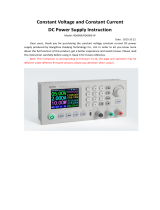
Copyright © Dr Robot Inc. 2005
2
IV.1
Multimedia Control................................................................................................................................ 61
IV.2 Events ..................................................................................................................................................... 64
V. WiRobot DRK6080/6000/8080/8000 Specific APIs .................................................................. 65
V.1 Low Level Protection.......................................................................................................................... 65
Chapter IV. WiRobot Module ..............................................................................................................66
I. PMS5005 Sensing and Motion Controller............................................................................................. 67
I.1 Introduction ............................................................................................................................................67
I.2 Operations ............................................................................................................................................. 69
I.3 Procedure to upgrade the PMS5005 firmware ............................................................................76
II. PMB5010 Multimedia Controller .............................................................................................................80
II.1 Introduction ...........................................................................................................................................80
II.2 Operations ..............................................................................................................................................81
II.3 Procedure to upgrade the PMB5010 firmware............................................................................ 85
III. MDM5253 DC Motor Driver Module with Position and Current Feedback....................................88
III.1 Introduction ...........................................................................................................................................88
III.2 Operations ............................................................................................................................................. 88
III.3 Connections ...........................................................................................................................................90
III.4 Specifications......................................................................................................................................... 91
IV. WFS802b WiFI 802.11 Serial Module with antenna .......................................................................... 93
IV.1 Introduction ........................................................................................................................................... 93
IV.2 Operations ............................................................................................................................................. 93
IV.3 Connections ........................................................................................................................................... 93
IV.4 Specifications........................................................................................................................................ 95
IV.5 Configuration via Serial Mode or Telnet Port................................................................................ 96
IV.6
Configuration
using
Web-Manager
................................................................................................... 116
V. MCB3100 WiRobot Serial Bluetooth Wireless Module.................................................................... 128
V.1 Introduction ......................................................................................................................................... 128
V.2 Operations ........................................................................................................................................... 128
V.3 Connections ......................................................................................................................................... 129
V.4 Specifications...................................................................................................................................... 130
VI. MAC5310 Audio Codec and Audio Power Amplifier Module ............................................................ 131
VI.1 Introduction .......................................................................................................................................... 131
VI.2 Operations ............................................................................................................................................ 131
VI.3 Connections .......................................................................................................................................... 131
VI.4 Specifications.......................................................................................................................................132
VII. DUR5200 Ultrasonic Range Sensor Module...................................................................................... 134
VII.1 Introduction ......................................................................................................................................... 134
VII.2 Operations ........................................................................................................................................... 134
VII.3 Connections ..........................................................................................................................................135
VII.4 Specifications.......................................................................................................................................136
VIII. DTA5102 Two-Axis Tilt and Acceleration Sensor Module ...............................................................137
VIII.1 Introduction ..........................................................................................................................................137
VIII.2 Operations ............................................................................................................................................137
VIII.3 Connections ..........................................................................................................................................139























